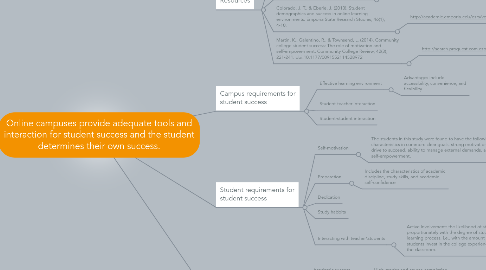
1. Define student success
1.1. Academic success
1.1.1. High grades and course completion
1.2. Retention
1.3. Meeting school goals
1.4. Development
1.4.1. developing communicating skills, learning how to learn, and how to think deeply.
2. Campus requirements for student success
2.1. Effective learning environment
2.1.1. Advantages include accessibility, convenience, and flexibility
2.2. Student-teacher interaction
2.3. Student-student interaction
3. Student requirements for student success
3.1. Self-motivation
3.1.1. The students in this study were found to have the following characteristics in common: clear goals, strong motivation and a drive to succeed, ability to manage external demands, and self-empowerment.
3.2. Preparation
3.2.1. Includes the characteristics of academic discipline, study skills, and academic self-confidence
3.3. Dedication
3.4. Study habbits
3.5. Interacting with teacher\students
3.5.1. Active Involvement: the likelihood of student success increases proportionately with the degree of student engagement in the learning process, i.e., with the amount of time and energy that students invest in the college experience—both inside and outside the classroom.
4. Resources
4.1. Aragon, S. R., Johnson, S. D., & Shaik, N. (2002). The influence of learning style preferences on student success in online versus face-to-face environments. The American Journal of Distance Education, 16(4), 227-243.
4.1.1. http://www.tandfonline.com.ezproxy2.apus.edu/doi/abs/10.1207/S15389286AJDE1604_3?journalCode=hajd20
4.2. Volery, T., & Lord, D. (2000). Critical success factors in online education. International Journal of Educational Management, 14(5), 216-223.
4.2.1. http://www.emeraldinsight.com/doi/abs/10.1108/09513540010344731
4.3. Colorado, J. T., & Eberle, J. (2010). Student demographics and success in online learning environments. Emporia State Research Studies, 46(1), 4-10.
4.3.1. http://academic.emporia.edu/esrs/vol46/colorado.pdf
4.4. Martin, K., Galentino, R., & Townsend, L. (2014). Community college student success: The role of motivation and self-empowerment. Community College Review, 42(3), 221-241. doi:10.1177/0091552114528972
4.4.1. http://search.proquest.com.ezproxy1.apus.edu/docview/1543467007?pq-origsite=summon&accountid=8289
